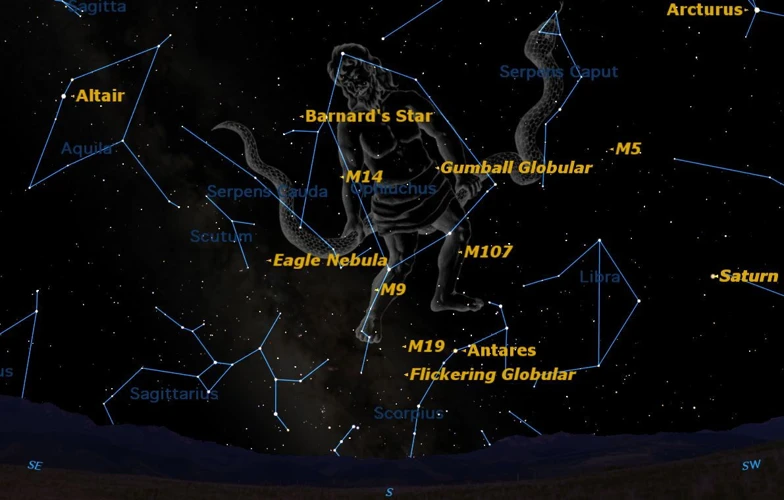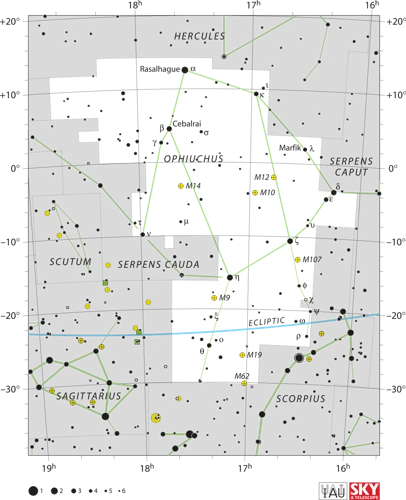The night sky has captured the imagination of humans for centuries, inspiring stories, art, and exploration. One fascinating aspect of our celestial fascination is the influence of culture on the naming and interpretation of constellations. From ancient civilizations to modern societies, each culture has left its unique mark on the stars above. In this article, we will delve into the rich tapestry of cultural influences that have shaped our understanding of the constellations. We will explore how Greek mythology and Egyptian beliefs contributed to constellation naming, as well as the Chinese, Indian, Native American, and Aboriginal cultural perspectives. Additionally, we will examine the various ways in which constellations have been interpreted through folklore, religion, art, and literature. Finally, we will discuss how globalization and the International Astronomical Union have standardized constellation names, while also acknowledging the contemporary contributions of indigenous cultures and reinterpretations of traditional constellations. Prepare to embark on a voyage through both ancient and modern cultural lenses to uncover the captivating stories behind the constellations.
Contents
- Ancient Civilizations and Constellation Naming
- Cultural Interpretations of Constellations
- Modern Astronomy and Standardized Naming
- Contemporary Cultural Contributions
- Conclusion
-
Frequently Asked Questions
- What is the significance of Greek mythology in constellation naming?
- How did the Egyptians contribute to constellation naming?
- What is the significance of Chinese constellations?
- What role did Indian culture play in constellation naming?
- What are some notable Native American and Aboriginal constellation names?
- How does folklore and religion influence the interpretation of constellations?
- How have artistic and literary interpretations shaped our understanding of constellations?
- What is the International Astronomical Union (IAU) and its role in constellation naming?
- How has globalization impacted constellation naming?
- How are contemporary cultures contributing to constellation naming?
- References
-
Frequently Asked Questions
- Why did ancient civilizations name constellations?
- How did Greek mythology influence constellation naming?
- What was the significance of Egyptian influence on constellation naming?
- What are some notable constellations in Chinese and Indian constellation systems?
- What are some examples of Native American and Aboriginal constellation names?
- How does folklore and religion influence the interpretation of constellations?
- How have constellations been interpreted in art and literature over the centuries?
- What are some multicultural perspectives on constellation meanings?
- Why did the International Astronomical Union (IAU) play a role in standardized constellation naming?
- How has globalization impacted the naming of constellations?
- References
- Read More
Ancient Civilizations and Constellation Naming

Ancient civilizations played a pivotal role in the naming and interpretation of constellations, leaving behind a rich cultural legacy that still influences our understanding today. Greek mythology holds a prominent place in constellation naming, with many constellations deriving their names from the heroic tales and gods of ancient Greece. The Zodiac constellations, for example, are deeply rooted in Greek mythology, representing the twelve signs of the zodiac and their associated personalities. Similarly, the Egyptians contributed their own unique perspective to constellation naming, intertwining their religious beliefs with celestial observations. Their constellations often represented deities and religious symbols, such as the goddess Isis and the scarab beetle. Moving beyond Europe, the Chinese and Indian civilizations developed their own intricate systems of constellations. Chinese constellations were closely tied to astrology and legend, with each constellation representing a different animal or mythological figure. In India, constellations were linked to the Hindu pantheon and reflected religious and cultural significance. Native American and Aboriginal cultures also had their own fascinating constellation names, featuring animals and natural elements that held deep spiritual meaning. These ancient civilizations are the foundation upon which our understanding of constellations was built, shaping our celestial narratives and providing a glimpse into the cultural tapestry of humanity.
Greek Mythology and Zodiac Constellations
Greek mythology has had a profound influence on constellation naming, particularly with regard to the Zodiac constellations. The twelve signs of the zodiac were believed to be representations of gods, goddesses, and mythical figures from Greek mythology. Aries, the first sign of the zodiac, is associated with the ram that carried the Golden Fleece sought by Jason and the Argonauts. Taurus, the second sign, is often represented by the bull form that Zeus assumed when abducting Europa. Gemini, the third sign, depicts the twins Castor and Pollux, also known as the Dioscuri. Cancer, the fourth sign, is associated with the story of Heracles (Hercules) and the Hydra, as it represents the giant crab sent to hinder his progress. Leo, the fifth sign, represents the majestic lion that was slain by Heracles as part of his Twelve Labors. Virgo, the sixth sign, represents the maiden associated with various myths and divine figures like Astraea and Persephone. Libra, the seventh sign, is symbolized by the scales of justice held by the goddess Themis. Scorpio, the eighth sign, represents the scorpion sent by Artemis to kill Orion, the great hunter. Sagittarius, the ninth sign, is depicted as a centaur, symbolizing the legendary Centaurs of Greek mythology. Capricorn, the tenth sign, represents the horned sea goat, a hybrid creature with the body of a fish and the head of a goat, associated with various gods like Pan and Zeus. Aquarius, the eleventh sign, is often depicted as the water-bearer Ganymede, who served as the cupbearer to the gods. Pisces, the twelfth sign, is symbolized by a pair of fish, representing Aphrodite and her son Eros, who transformed into fish to escape the monster Typhon. These stories and symbols from Greek mythology have given life and meaning to the constellations that make up the zodiac, shaping the way we understand astrology and our own identities in relation to the stars.
For more information on astrology and zodiac signs, you can explore the compatibility between fire signs or learn about the lesser-known constellation of Ophiuchus, which has its own intriguing symbolism rooted in ancient mythology and folklore.
Egyptian Influence on Constellation Naming
The ancient Egyptians had a significant influence on the naming of constellations, infusing them with their unique religious and cultural beliefs. In Egyptian mythology, the stars were closely connected to the divine realm and were believed to be the dwelling places of gods and goddesses. This belief was reflected in their constellation names and interpretations. For example, the constellation Orion was associated with the god Osiris, the lord of the underworld and the afterlife. Its bright stars were seen as representations of Osiris and were of great importance in Egyptian religious rituals and ceremonies. Another prominent constellation, Ursa Major (the Great Bear), was associated with the goddess Isis and was believed to symbolize her protective and nurturing qualities.
One particularly fascinating constellation in Egyptian mythology is Draco, representing a serpent or a dragon. This constellation was linked to the god Apep, the ancient symbol of chaos and destruction. Egyptians believed that each night, the gods would battle against Apep to ensure the rising of the sun in the morning. This cosmic struggle between good and evil was reflected in their understanding of the Draco constellation. It symbolized the eternal battle between order and chaos, light and darkness.
The influence of Egyptian culture on constellation naming can still be felt today, as many of the ancient names given by the Egyptians have been preserved and are widely recognized. The rich symbolism and spiritual significance embedded within these constellations provide a fascinating glimpse into the worldview of this ancient civilization. Understanding the Egyptian influence on constellation naming allows us to appreciate the depth and complexity of human beliefs and the way in which they shaped our understanding of the night sky. To explore more about ancient mythology and folklore, you can also read about the Ophiuchus symbol in ancient mythology and folklore.
Chinese and Indian Constellation Systems
Chinese and Indian civilizations developed intricate and unique systems of constellations, each with its own distinct cultural influences and interpretations. In Chinese astronomy, constellations were closely connected to astrology and played a crucial role in determining one’s destiny. The Chinese Zodiac, consisting of twelve animal signs, is perhaps the most well-known aspect of their constellation system. Each animal sign is believed to have certain personality traits and characteristics that influence a person’s life. The Chinese also recognized other celestial patterns, such as the Four Symbols, representing the Azure Dragon, Vermilion Bird, White Tiger, and Black Tortoise. These symbols were associated with cardinal directions and seasons, further emphasizing the connection between the heavens and earthly existence.
In contrast, Indian astronomy blended scientific observation with religious and philosophical beliefs. The Indian system of constellations, known as Nakshatras, consisted of 27 or 28 divisions along the ecliptic. Each Nakshatra was associated with a particular deity, reflecting the spiritual significance and cosmic energy attributed to them. These constellations played a vital role in Vedic astrology, guiding important life events and shaping an individual’s personality traits. The Nakshatras were also associated with the twelve houses in the Indian astrological chart, influencing different aspects of a person’s life, such as family, wealth, and relationships. The complex interplay between astronomy, religion, and astrology in Indian culture highlights the depth of understanding and reverence for the stars.
Both Chinese and Indian constellation systems demonstrate the profound cultural significance of the night sky in these ancient civilizations. These constellations not only served as guides for navigation but also held symbolic and spiritual meaning, influencing various aspects of daily life. Their rich narratives and interpretations continue to captivate and inspire people around the world to explore the depth and interconnectedness of the universe.
Native American and Aboriginal Constellation Names
Native American and Aboriginal cultures have their unique constellation names, reflecting their deep connection to the natural world and spiritual beliefs. These indigenous peoples viewed the stars as important guides and storytellers, with constellations playing a significant role in their oral traditions. One example is the Lakota tribe of North America, who referred to the constellation commonly known as Orion as “The Hand” or “The Hand of the Warrior,” representing the handprint of an ancestral warrior. The Navajo people recognize the constellation Cassiopeia as “The Celestial Rabbit,” symbolizing the trickster figure in their folklore. Aboriginal cultures in Australia have their own rich tapestry of constellation names, deeply rooted in Dreamtime stories and creation myths. The Pleiades star cluster, commonly known as the Seven Sisters, holds great importance in many Aboriginal cultures. It is often associated with the story of the Seven Sisters who fled from the relentless pursuit of a forbidden relationship and transformed into stars to escape. These examples demonstrate the intimate relationship between indigenous cultures and the constellations, revealing the profound cultural significance of the night sky. So, it is fascinating to explore the Native American and Aboriginal constellation names and the stories they tell, providing a unique perspective on our celestial surroundings.
Cultural Interpretations of Constellations

Cultural interpretations of constellations add a layer of depth and significance to our understanding of the night sky. Folklore and religion play a major role in shaping these interpretations, as they provide stories and symbolic meanings to the celestial patterns. Folklore often weaves tales around constellations, giving them personalities and narratives from different cultures. These stories serve to preserve cultural history and pass down knowledge from one generation to another. Religion, on the other hand, infuses constellations with spiritual and divine significance. For example, the constellation Orion has been associated with the Greek mythological figure of the hunter Orion, known for his great strength and bravery. In artistic and literary interpretations, constellations become a source of inspiration for creative works. Artists and writers throughout history have sought to capture the beauty and wonder of the constellations in various forms of expression. Multicultural perspectives offer diverse interpretations of constellation meanings. Different cultures may ascribe different symbols or stories to the same group of stars. This reflects the rich tapestry of human experience and reminds us of the universal human instinct to seek meaning and connection in the world around us. Whether through folklore, religion, art, or multicultural perspectives, cultural interpretations of constellations provide us with a glimpse into the diverse beliefs and rich imagination of humanity. They add depth and wonder to our exploration of the night sky and remind us of the innate human desire to find meaning in the cosmos.
The Influence of Folklore and Religion
The influence of folklore and religion on the interpretation of constellations is profound and far-reaching. In various cultures, constellations are imbued with mythological tales and religious significance, adding layers of meaning to the celestial patterns. In Greek mythology, for instance, the constellation Orion is associated with the story of a mighty hunter. According to legend, Orion boasted that he could kill any animal on Earth, which angered the goddess Artemis. As a punishment, she sent a scorpion to kill him, resulting in the constellations of Orion and Scorpius forever being on opposite sides of the sky. Similarly, the constellation Ursa Major, also known as the Great Bear, holds significance in both Native American and Greek mythology. While the Greeks believed it represented the nymph Callisto, who was turned into a bear by the goddess Hera, Native American tribes saw it as the Great Bear, a central figure in their creation stories. In Nordic folklore, the constellation Draco, the dragon, is associated with mighty creatures that guarded treasure. These folklore stories add a sense of wonder and excitement to our understanding of the constellations, connecting us to ancient beliefs and traditions. Religion also plays a significant role in constellation interpretation. In Hinduism, for example, the constellation Arundhati is considered a symbol of marital devotion, with married couples looking to that star for blessings. The Big Dipper, a prominent constellation in various cultures, has been associated with different religious beliefs, such as a ladle pouring the waters of life or a bear’s tail in Native American and ancient Greek cultures, respectively. Such religious interpretations highlight the profound impact spirituality has on shaping our understanding and perception of the celestial world.
Artistic and Literary Interpretations
Artistic and literary interpretations of constellations have added depth and nuance to our understanding of these celestial formations. Artists throughout history have captured the beauty and mystique of the night sky, often incorporating constellations into their works. Paintings, sculptures, and even tapestries have featured constellations as prominent elements, imbuing them with a sense of wonder and awe. The artwork of Vincent van Gogh is a prime example, with his renowned painting “Starry Night” depicting a vivid night sky filled with swirling stars and a prominent crescent moon. These artistic representations not only showcase the beauty of constellations but also evoke emotions and provoke contemplation.
Likewise, literature has provided a platform for exploring the meanings and symbolism behind constellations. Poets and writers have crafted vivid descriptions, weaving together stories and meanings associated with specific constellations. Authors like Jorge Luis Borges in “The Book of Imaginary Beings” and Italo Calvino in “Cosmicomics” have delved into the poetic interpretations of constellations, offering unique perspectives on their significance and the human experience. These literary works have taken readers on imaginative journeys through the cosmos, intertwining the scientific, mythological, and philosophical realms.
The artistic and literary interpretations of constellations have allowed for a deeper exploration of their symbolism and significance. They encourage us to look beyond the scientific aspects and contemplate the larger questions of existence and our place in the universe. Through creative expression, artists and writers have breathed life into the constellations, inviting us to embark on imaginative adventures under the starry skies. To learn more about the significance of the first house in astrology, click here.
Multicultural Perspectives on Constellation Meanings
Multicultural perspectives on constellation meanings offer a diverse and enriching tapestry of interpretations. Folklore and religion heavily influence how constellations are perceived in different cultures. In some cultures, constellations are associated with origin stories or significant events in their mythologies. For example, the Pleiades cluster, also known as the Seven Sisters, has different interpretations across cultures. In Greek mythology, these stars represent the daughters of the titan Atlas, who were transformed into stars to escape the pursuit of Orion. On the other hand, in Indigenous Australian Dreamtime stories, the Pleiades are known as the Seven Sisters, revered as important ancestral beings who guided and protected the people. Constellations are also often interpreted through an artistic and literary lens. Artists and writers draw inspiration from the stars to convey various themes and emotions in their works. Whether through poetry, paintings, or songs, constellations can symbolize love, longing, courage, or triumph. Additionally, multicultural perspectives shed light on how different cultures assign unique meanings to constellations. For instance, the constellation Ursa Major, or the Great Bear, holds significance in Native American cultures, symbolizing a bear spirit guide that brings protection and strength. Each culture breathes life into the constellations, infusing them with stories, symbolism, and interpretations that resonate deeply with their traditions and beliefs. Understanding these multicultural perspectives expands our appreciation for the rich diversity of human imagination and creativity when it comes to the interpretation of the night sky.
Modern Astronomy and Standardized Naming

In contrast to the diverse and culturally influenced naming practices of ancient civilizations, modern astronomy has adopted a standardized approach to constellation naming. The International Astronomical Union (IAU), an organization composed of professional astronomers, plays a vital role in this process. The IAU is responsible for officially recognizing and naming celestial objects, including constellations. Through this standardization, constellations are identified by specific names and boundaries, ensuring consistency across scientific research and astronomical equipment. One of the most notable contributions of the IAU is the creation of the official constellation boundaries, which are universally recognized and used in modern astronomy. These boundaries divide the sky into 88 constellations, each with its own designated name and set of stars. The standardized naming system allows astronomers worldwide to effectively communicate and coordinate their research. However, it is important to acknowledge that this standardized approach may overlook the cultural significance and diverse interpretations associated with constellations. While modern astronomy has made significant strides in categorization and standardization, it is essential to recognize and respect the cultural contributions that shaped our understanding of these celestial wonders.
The International Astronomical Union (IAU)
The International Astronomical Union (IAU) plays a crucial role in standardizing constellation naming and ensuring consistency in the scientific community. Founded in 1919, the IAU is responsible for defining and officially recognizing constellations, as well as assigning names to stars and other celestial objects. One of the significant contributions of the IAU is the establishment of the modern constellation boundaries, dividing the sky into 88 different regions. This system allows astronomers from around the world to communicate effectively and share their observations. The IAU has developed guidelines for naming celestial objects, ensuring that names are based on scientific, historical, or cultural significance. They have also facilitated the inclusion of diverse cultural perspectives by encouraging the recognition and inclusion of traditional names alongside scientific designations. Although the IAU provides the standard framework for constellation naming, it is important to acknowledge that cultural interpretations and contributions remain an integral part of the celestial tapestry. By striking a balance between scientific precision and cultural inclusivity, the IAU continues to play a vital role in preserving the integrity and accessibility of constellation naming.
Impact of Globalization on Constellation Naming
The impact of globalization on constellation naming cannot be ignored in the modern era. With increased interconnectivity and the exchange of cultures, there has been a push for standardized naming practices to foster universal understanding. The International Astronomical Union (IAU) plays a vital role in this process by officially recognizing and naming celestial objects. Through their efforts, constellations are given scientifically accepted names that transcend cultural boundaries. While this standardization has its advantages in terms of scientific communication, it also raises questions about the preservation of cultural diversity and indigenous knowledge. Some argue that the homogenization of constellation names diminishes the cultural significance and diversity associated with them. However, others argue that standardization allows for greater accessibility and inclusivity in astronomy. It is essential to strike a balance between preserving cultural heritage and advancing scientific progress in constellation naming. Despite the push for standardization, contemporary cultural contributions continue to emerge. Indigenous cultures around the world are reclaiming their narratives and creating new constellations inspired by their ancestral knowledge and traditions. This revitalization adds vibrancy to the field of astronomy and helps to preserve the cultural heritage embedded in the stars. The impact of globalization on constellation naming is a complex issue that requires ongoing dialogue and consideration of the diverse perspectives involved.
Link: meaning and significance of the first house
Contemporary Cultural Contributions

Contemporary cultural contributions to constellation naming and interpretation have added new layers of diversity and creativity to the celestial landscape. Inspired by indigenous cultures, there have been efforts to highlight their rich astronomical traditions and incorporate their unique stories into the night sky. For example, the Wurundjeri people of Australia have proposed new constellations that honor their Aboriginal heritage and reflect their connection to the land and celestial bodies. This includes constellations representing the Black Swan and the Boomerang, both significant symbols in Aboriginal culture. In addition to new constellations, there has also been a reimagining of traditional constellations from a multicultural perspective. Artists and astronomers have collaborated to give new names and interpretations to familiar constellations, taking inspiration from various cultures around the world. This inclusive approach fosters a sense of unity and appreciation for the diverse narratives that different cultures bring to the stars above. These contemporary contributions serve as a reminder that the cosmic realm continues to be a source of inspiration and cultural expression, bridging the gap between the ancient origins of constellation names and the ever-evolving interpretations in the modern era. Whether through the creation of new constellations or the reinterpretation of existing ones, these contemporary cultural contributions offer a refreshing and inclusive perspective that reflects our interconnected global society.
New Constellations Inspired by Indigenous Cultures
In recent years, there has been a growing movement to recognize and honor the diverse cultures of indigenous peoples by creating new constellations inspired by their rich traditions and stories. This initiative seeks to not only preserve indigenous knowledge but also to promote inclusivity and representation in the field of astronomy. One notable example is the constellation “The Emu in the Sky,” which was added to the southern hemisphere sky to acknowledge the significance of the emu in Aboriginal Australian culture. This constellation tells the story of the celestial Emu who represents fertility and the changing seasons. Another example is the constellation “The Creator’s Hands,” also known as Goochihooka, which was named by the Ojibwe people of North America. It symbolizes the Great Spirit’s hands shaping and guiding the universe. These new constellations are a testament to the cultural contribution of indigenous peoples and serve as a reminder that the night sky is not only a scientific marvel but also a canvas for diverse stories and perspectives. Through these newfound celestial additions, indigenous cultures are celebrated and their ancestral wisdom is preserved for generations to come.
Cultural Reinterpretations of Traditional Constellations
Cultural reinterpretations of traditional constellations add a fascinating layer of diversity and creativity to our understanding of the stars. As cultures evolve and embrace new perspectives, they often reevaluate and reinterpret the meanings of existing constellations. This phenomenon can be seen in various forms, including art, literature, and even scientific research. Artists, for instance, often incorporate their cultural backgrounds and narratives into their portrayals of constellations. They may infuse traditional celestial figures with symbols, motifs, and aesthetics that are specific to their cultural heritage. This artistic reinterpretation not only breathes new life into familiar constellations but also invites viewers to explore different cultural perspectives. Writers also contribute to the cultural reinterpretation of constellations through their storytelling. They might weave tales that reimagine the origins and symbolism of constellations, incorporating cultural themes and values into their narratives. In some cases, scientific research draws inspiration from cultural reinterpretations, as astronomers delve into the cultural histories of constellations to gain a deeper understanding of their significance. By exploring the ways traditional constellations are reimagined within different cultures, we gain insight into the ever-evolving nature of both astronomy and human interpretation.
Conclusion

In conclusion, it is evident that culture has a profound influence on the naming and interpretation of constellations. Ancient civilizations such as the Greeks, Egyptians, Chinese, Indians, Native Americans, and Aboriginal cultures all contributed their unique perspectives and beliefs to the rich tapestry of constellation naming. Whether through mythology, religion, astrology, or spiritual significance, these cultural influences have shaped our understanding of the night sky. Moreover, the modern era has seen the standardization of constellation names through the efforts of the International Astronomical Union, symbolizing the impact of globalization on celestial narratives. However, contemporary cultural contributions continue to shape our constellations, with indigenous cultures inspiring new constellations and reinterpretations of traditional ones. As our understanding of the universe evolves, so too will our interpretations of the constellations, reflecting the ever-changing cultural landscape of humanity. The influence of culture on constellation naming and interpretation serves as a reminder of the interconnectedness between the celestial and human realms, bridging ancient wisdom with modern understanding.
Frequently Asked Questions

What is the significance of Greek mythology in constellation naming?
Greek mythology greatly influenced constellation naming, with many constellations deriving their names from the heroic tales and gods of ancient Greece. The Zodiac constellations, for example, represent the twelve signs of the zodiac and their associated personalities.
How did the Egyptians contribute to constellation naming?
The Egyptians incorporated their religious beliefs into constellation naming, with constellations often representing deities and religious symbols. For example, the constellation Orion is associated with the god Osiris, and the constellation Ursa Major represents the goddess Isis.
What is the significance of Chinese constellations?
Chinese constellations are closely tied to astrology and legend. Each constellation represents a different animal or mythological figure, and they are used to predict future events and guide personal attributes based on the year of birth.
What role did Indian culture play in constellation naming?
In Indian culture, constellations are linked to the Hindu pantheon and carry religious and cultural significance. They are often associated with stories from Hindu mythology and serve as a guide for religious practices and rituals.
What are some notable Native American and Aboriginal constellation names?
Native American and Aboriginal cultures have their own unique constellation names. For example, the Pawnee tribe named the constellation Pleiades as the “Stars with Tails,” and the Australian Aboriginals referred to the constellation Orion as the “Emu in the Sky.”
How does folklore and religion influence the interpretation of constellations?
Folklore and religion play a significant role in interpreting constellations. Different cultures attribute various meanings and stories to the arrangement of stars, often intertwining them with mythical tales, religious beliefs, and spiritual practices.
How have artistic and literary interpretations shaped our understanding of constellations?
Artistic and literary interpretations have contributed to the cultural significance of constellations. Artists and writers throughout history have depicted and referenced constellations in their works, adding layers of meaning and symbolism to their representations.
What is the International Astronomical Union (IAU) and its role in constellation naming?
The International Astronomical Union (IAU) is the authority responsible for naming celestial objects, including constellations. Their standardization efforts ensure consistency and facilitate scientific communication across cultures and countries.
How has globalization impacted constellation naming?
Globalization has played a role in standardizing constellation names and providing a universally recognized system. It has also allowed for the exchange and integration of cultural perspectives, resulting in a more diverse understanding of constellations.
How are contemporary cultures contributing to constellation naming?
Contemporary cultures continue to contribute to constellation naming. Indigenous cultures, for example, have inspired the creation of new constellations that reflect their traditions and stories. Additionally, reinterpretations of traditional constellations incorporate modern cultural perspectives into the celestial narrative.
References
- Stars, Constellations, Beliefs – Nature worship
- The Origin of the Greek Constellations
- Constellations Across Cultures: How Our Visual Systems …
Frequently Asked Questions

Why did ancient civilizations name constellations?
Ancient civilizations named constellations to help them navigate the night sky and make sense of their surroundings. These celestial patterns served as a way to organize and interpret the vastness of the cosmos.
How did Greek mythology influence constellation naming?
Greek mythology played a significant role in constellation naming. Many constellations, such as Orion and Hercules, were named after prominent figures in Greek mythology. The stories associated with these mythical characters helped people remember and identify the constellations.
What was the significance of Egyptian influence on constellation naming?
Egyptian culture influenced constellation naming by associating celestial objects with their religious beliefs and deities. Many constellations were named after Egyptian gods and goddesses, connecting their mythology with the stars in the sky.
What are some notable constellations in Chinese and Indian constellation systems?
In Chinese astronomy, constellations such as the Azure Dragon and the Vermillion Bird hold great importance. In Indian astronomy, constellations like the Seven Sages (Saptarishi) and the Pleiades (Krittika) are well-known.
What are some examples of Native American and Aboriginal constellation names?
Native American and Aboriginal cultures have their unique constellations. For example, the Lakota tribe has the constellation Mato Tipila, which represents Bear’s Lodge, also known as Devil’s Tower. Aboriginal Australians have constellations like the Emu in the Sky and the Seven Sisters.
How does folklore and religion influence the interpretation of constellations?
Folklore and religion shape the interpretation of constellations by providing cultural stories and beliefs associated with specific celestial patterns. These interpretations often reflect the values, customs, and spiritual significance of a particular community or society.
How have constellations been interpreted in art and literature over the centuries?
Constellations have been a rich source of inspiration in art and literature. Artists and writers often associate various meanings, emotions, and narratives with different constellations. They use them as metaphors or symbols to convey complex ideas and emotions.
What are some multicultural perspectives on constellation meanings?
There are diverse multicultural perspectives on constellation meanings. For instance, some cultures associate specific constellations with agricultural seasons, while others connect them to historical events or ancestral stories. These perspectives reflect the rich diversity of human cultures worldwide.
Why did the International Astronomical Union (IAU) play a role in standardized constellation naming?
The IAU played a role in standardized constellation naming to ensure consistency and clarity in scientific communication. By establishing agreed-upon constellation boundaries and naming conventions, astronomers around the world can communicate and collaborate effectively.
How has globalization impacted the naming of constellations?
Globalization has contributed to the exchange and integration of various constellation naming conventions. Astronomers from different cultures now collaborate, leading to the adoption of new constellation names and the recognition of cultural diversity in the naming process.
References
- Constellations Across Cultures: How Our Visual Systems …
- Constellations according to different cultures







